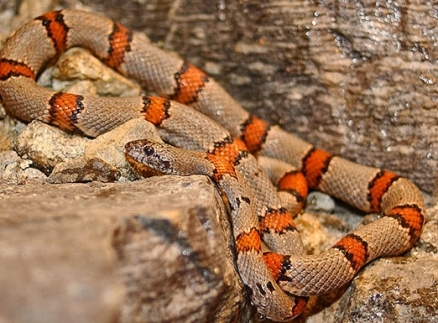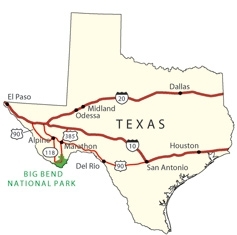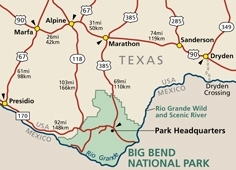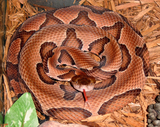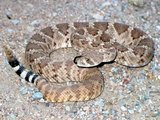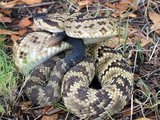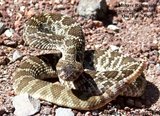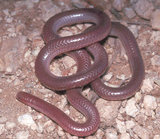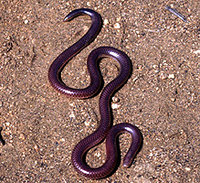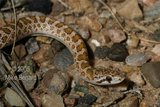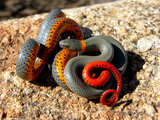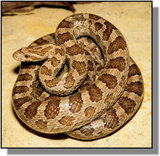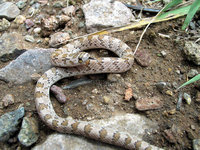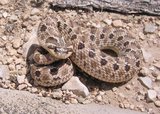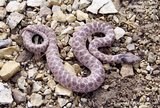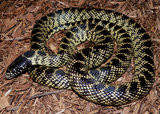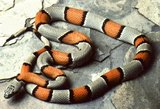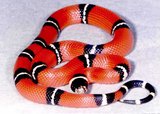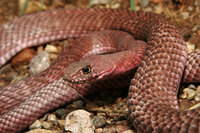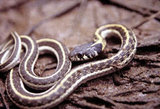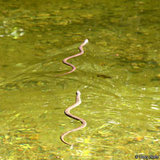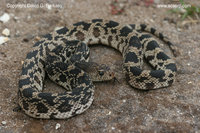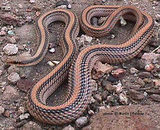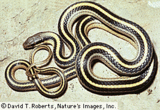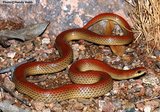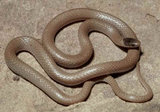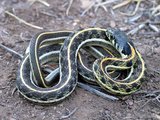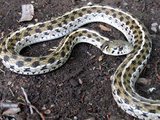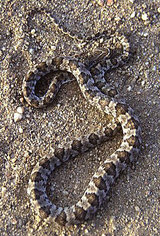Snakes of Big Bend National Park
There are a number of snakes of Big Bend National Park, which divide into three different families. Big Bend National Park in the remote Southwest Texas, USA is a beautiful region of protected desert ecology and is home to hundreds of animal species.
Of these species, 31 are snakes which make up the largest group reptiles in the park. Of these 31 species of snakes found in the park,five (four rattlesnakes andone copperhead) are venomous and dangerous to humans if a bite is inflicted.
|
The location of Big Bend National Park in the state of Texas, USA. Source: National Park Service |
There are three different families of snakes found in Big Bend National Park,Viperidae (True Vipers), the Leptotyphlopidae (Blind Snakes), and the Colubridae (Colubrids).
Contents
- 1 Family Viperidae
- 2 Family Leptotyphlopidae
- 3 Family Colubridae
- 3.1 Glossy Snake (Arizona elegans)
- 3.2 Ringneck Snake (Diadophis punctatus)
- 3.3 Great Plains Rat Snake (Elaphe guttata)
- 3.4 Baird's Rat Snake (Elaphe bairdi)
- 3.5 Trans-Pecos Rat Snake (Bogertophis subocularis)
- 3.6 Western Hooknose Snake (Gyalopion canum)
- 3.7 Western Hognose Snake (Heterodon nasicus)
- 3.8 Spotted Night Snake (Hypsiglena torquata)
- 3.9 Desert Kingsnake (Lampropeltis getula)
- 3.10 Grey-banded Kingsnake (Lampropeltis alterna)
- 3.11 Milk Snake (Lampropeltis triangulum)
- 3.12 Coachwhip or Red Racer(Masticophis flagellum)
- 3.13 Striped Whipsnake (Masticophis taeniatus)
- 3.14 Blotched Water Snake (Nerodia erythrogaster)
- 3.15 Bullsnake (Pituophis melanoleucus)
- 3.16 Long-nosed Snake (Rhinocheilus lecontei)
- 3.17 Big Bend Patch-nosed Snake (Salvadora deserticola)
- 3.18 Mountain Patch-nosed Snake (Salvadora grahamiae)
- 3.19 Ground Snake (Sonora semiannulata)
- 3.20 Southwestern Black-headed Snake (Tantilla hobartsmithi)
- 3.21 Blackhood Snake (Tantilla cucullata and Tantilla rubra)
- 3.22 Black-necked Garter Snake (Thamnophis cyrtopsis)
- 3.23 Checkered Garter Snake (Thamnophis marcianus)
- 3.24 Lyre Snake (Trimorphodon biscutatus)
- 4 References and Further Reading
Family Viperidae
The family Viperidae is a family of venonmous snakes that are most identified with true vipers. They have long, hollow, fangs that are used to inject venom from its glands. Their venom is harmful to humans.Five members in this family can be found in Big Bend National Park.
Copperhead (Agkistrodon contortrix)
This thick bodied snake grows from 22-54 inches (56-137 centimeters) in length. Their typical coloration is a red-brown, sometimes tinged with orange or pink and with darker, bold bands. This mainly nocturnal species prey on lizards, frogs, insects, and small mammals. They are rare in the park and are found park wide but are more common near water.
Western Diamondback Rattlesnake (Crotalus atrox)
These large rattlesnakes grow from 30-85 inches (76-216 centimeters) in length. Their coloration is from grey to black, light red, to yellow-green. They are mainly nocturnal and active on hot, dry nights. They prey on small mammals, lizards, and birds. They are common in the park and are found in the Rio Grande floodplain to the Chisos Mountains foothills.
Rock Rattlesnake (Crotalus lepidus)
These snakes, on average grow from 16-32 inches (41-81 centimeters) in length. They vary in color from green-grey, blue-grey, pink, to tan with dark bands along its back. These nocturnal and diurnal snakes prey on lizards, snakes, and small mammals. They are uncommon and found park wide, but are most common in the Chisos Mountains and foothills.
Black-tailed Rattlesnake (Crotalus molossus)
These snakes grow from 28-50 inches (71-127 centimeters) in length. They vary in color from green-yellow to grey with black or dark grey patches along its back. These nocturnal and diurnal snakes prey on small mammals. They are common and found park wide but are most common in the Chisos Mountains and foothills.
Mojave Rattlesnake (Crotalus scutulatus)
These rattlesnakes grow from 24-50 inches (61-127 centimeters) in length. Their overall color is variable, usually with some shades of green. They have a series of brown diamonds, rectangles, or ovals uniformly edged with light yellow or white scales on their back. These mainly nocturnal species prey on small mammals. They are uncommon in the park and can be found in the Rio Grande floodplain to about 4000 feet.
Family Leptotyphlopidae
The family Leptotyphlopidae, slender blind snakes,contains 90 species. They are a diverse family that lives in a variety of different habitats that range from rainforests to semideserts, and termite burrows to trees tops. There aretwo species of Leptotyphlopidae in Big Bend National Park. They are the New Mexico Blind Snake (Leptotyphlops Dulcis) and the Trans-Pecos Blind Snake (Leptoyphlops humilis).
New Mexico Blind Snake (Leptotyphlops dulcis)
The New Mexico Blind Snake grows on average from 7-16 inches (18-41 centimeters) in length. This snake looks like an earthworm. Its color ranges from brown to pink in color and the snake has a deep sheen in its scales. The snake has two dark dots under its head scales to serve as eyes. The snake is uncommon in the park and is only found in the Chisos Mountain range. This nocturnal snake is most active after rain and feeds on ants and termites.
Trans-Pecos Blind Snake (Leptoyphlops humilis)
The Trans-Pecos Blind Snake, like the New Mexico Blind Snake, grows to an average length of 7-16 inches (18-41 centimeters). This blind snake looks very similar to the New Mexico Blind Snake. It however has only 1 head scale between the plates that cover its eyes. It is fairly rare in the park and can only be found in the Rio Grande floodplain to the mountain foothills. Like the New Mexico Blind Snake, the Trans-Pecos Blind Snake is nocturnal and is most active after rain. It preys on ants and termites.
Family Colubridae
The Colubrids make up the largest family of known snakes. These snakes come in many diverse sizes and colors. Most have wide scales on their bellies and, usually, nine large scales on the tops of their heads. There are 23 species of Colubrids in Big Bend National Park.
Glossy Snake (Arizona elegans)
The Glossy Snake grows to a maximum length of 42 inches (107 centimeters). This is a small, narrow headed snake that comes in a variety of skin colors that include, tan, brown, or grey and has spotted patterns. The coloration depends on the soil and habitat that they live in. In the park, they are uncommon and only found in the Rio Grande floodplain to the foothills (up to Panther Junction and lower Green Gulch). This snake is nocturnal and is most active after rain. This snake preys on small mammals and lizards andis most active after rain.
Ringneck Snake (Diadophis punctatus)
This slender snake tends to grow on average between 10-14 inches (25-37 centimeters) in length. It is usually black or grey in color. This diurnal and nocturnal snake feedson insects, frogs, salamanders, snakes, lizards, and small mammals. They are uncommon in the park and are usually only found in the Chisos Mountains and foothills but have also been found in other mountains and canyon lowlands along Rio Grande River.
Great Plains Rat Snake (Elaphe guttata)
These snakes are somewhat larger and stockier than other snakes in the region. Adults range in a total of length 24-48 inches (61-122 centimeters). They vary in color from grey to olive and brown. This nocturnal and diurnal snake primarily preys on small rodents but can eat birds, insects, and other snakes. They are rare in the park and are only found in the Rio Grande floodplain.
Baird's Rat Snake (Elaphe bairdi)
These snakes range from 25-55 inches (64-140 centimeters) in length. They vary in color from orange-yellow to bright yellow, or a darker salmon ground color. Their belly is generally grey or yellow. They havefour stripes that run from neck to tail. These nocturnal and diurnal snakes primarily prey on small rodents but are known to eat birds and lizards. They are rare in the park and are only found in the Chisos Mountains above 4000 feet.
Trans-Pecos Rat Snake (Bogertophis subocularis)
These snakes, on average, range from 31-47 inches (79-119 centimeters) in length. They vary in color from grey to orange and red depending on their habitat. They are nocturnal and are most active on hot nights. They normally prey on small mammals but also eat birds and even bats. They are uncommon in the park and are found in the Rio Grande floodplain to Chisos Mountains foothills below 5000 feet.
Western Hooknose Snake (Gyalopion canum)
These snakes are small and grow up to a maximum length of 15 inches (38 centimeters). They are relatively stout-bodied, grey, yellow-brown colored snake with brown bars across the top of its body. These nocturnal snakes prey on small spiders, insects, centipedes, and scorpions. They are rare in the park and are found from the Chisos Mountains to Rio Grande River.
Western Hognose Snake (Heterodon nasicus)
These snakes can grow, on average, from 15-33 inches (39-84 centimeters) in length. They do not exhibit much variation in color and are mostly light brown in color with grey or brown blotches on their back. This diurnal species preys on amphibians, lizards, and rodents. They are rare in the park and are only found in Panther Junction.
Spotted Night Snake (Hypsiglena torquata)
These snakes normally grow from 12-16 inches (31-41 centimeters) in length. They vary in color from grey to brown with darker grey or brown spots. They mainly prey on amphibians and lizards. These nocturnal species are common in the park and are found in the Rio Grande floodplain to Chisos Basin.
Desert Kingsnake (Lampropeltis getula)
This large species of snake grows to an average length of 56 inches (142 centimeters). Coloration varies between subspecies but most are black or dark brown and may have spots or strips. They are nocturnal and most often seen after rains. They prey on snakes, mice, rats, lizards, amphibians, reptile eggs, small turtles, and birds. They are rare in the park and are only found in the Rio Grande floodplain to Chisos Mountains foothills.
Grey-banded Kingsnake (Lampropeltis alterna)
These snakes, on average, grow to 36 inches (91 centimeters) in length. This snake has a broad grey bands surrounded in smaller black bands that are outlined in a single row of white scales. This nocturnal species preys on lizards, snakes, and small rodents. This snake is one of the rarest in the park and in the United States. They are only found in the Chisos Mountains and foothills of the park.
Milk Snake (Lampropeltis triangulum)
These snakes range from 20-60 inches (51-152 centimeters) in length. They typically have a color pattern of red-black-yellow or white-black-red. They are nocturnal and are most active after rain. They mainly prey on small rodents but have been known to eat insects, eggs, birds, lizards, amphibians, and other snakes. They are very rare in the park and are only found in the Chisos Mountains and foothills.
Coachwhip or Red Racer(Masticophis flagellum)
These thin bodied snakes, on average, grow up to 62 inches (156 centimeters) in length. They vary greatly in color but mostly blend in with their habitat. In the park, they are mainly reddish-brown to bright reddish-pink. This diurnal species prey on birds, rodents, lizards, other snakes, small turtles, bird eggs, and insects. They are a very common snake in the park and are most commonly found from the Rio Grande floodplain to the Chisos Mountain foothills.
Striped Whipsnake (Masticophis taeniatus)
These slender snakes range from 30-75 inches (76-191 centimeters) long. They vary in color from dark grey and brown to black. They are a diurnal species that mainly prey on amphibians, and smaller reptiles. They are uncommon in the park and are found park wide except for possibly the highest parts of the Chisos Mountains.
Blotched Water Snake (Nerodia erythrogaster)
These snakes are a medium size snake and range from 24-36 inches (61-91 centimeters) in length. They are olive green or brown in color with greyish brown blotches across their backs. They are rare in the park and are only found along the Rio Grande between the hot springs and Boquillas Canyon.
Bullsnake (Pituophis melanoleucus)
The Bullsnake is a large snake that on average grows to 72 inches (183 centimeters) in length. They are generally yellow in color with brown, black, or even red blotching patterns on their back. These nocturnal and diurnal snakes prey on small mammals, insects, birds, lizards, and other snakes. They are uncommon in the park but can be found park wide.
Long-nosed Snake (Rhinocheilus lecontei)
These are slender snakes that on average grow up to 36 inches (91 centimeters) in length. Their coloration varies considerably but most are banded or blotched with white, black, and in some cases red. These snakes are nocturnal and most active after rain. They prey on lizards, lizard eggs, and small mammals. They are uncommon in the park and are found in the Rio Grande floodplain to Chisos Mountains and north to the Rosillos Mountains.
Big Bend Patch-nosed Snake (Salvadora deserticola)
On average, this snake grows up to 22-40 inches (56-102 centimeters) in length. They are a lined snake with 1 light brown strip surrounded by two dark brown or black strips that extend from neck to tail. These diurnal snakes mainly prey on lizards. They are uncommon in the park and can be found in the Rio Grande floodplain to Chisos Mountains and foothills.
Mountain Patch-nosed Snake (Salvadora grahamiae)
These snakes are a medium size slender snake that can grow up to 36 inches (91 centimeters) in length. They are a tan or cream colored snake with two wide, straight-edged, dark brown or black stripes on the back. This diurnal species prey on other snakes, eggs, lizards, birds, and small mammals. They are uncommon in the park but can be found in the Chisos Mountains and foothills down to Panther Junction.
Ground Snake (Sonora semiannulata)
These are small snakes that grow, on average, up to 19 inches (48 centimeters) in length. They come in many different colors from solid brown to banded red and black. They are nocturnal and active on hot, dry nights. They prey on insects, spiders, scorpions, centipedes, and lizards. They are uncommon in the park and are found in the Rio Grande floodplain to Chisos Mountains foothills up to 5000 feet in Green Gulch.
Southwestern Black-headed Snake (Tantilla hobartsmithi)
These small slender snakes grow at most up to 12 inches (31 centimeters) in length. They are light grey, light brown, or tan with a black or dark brown head cap. This nocturnal species eats a variety of insects. They are common in the park and can be found in the Dagger to the foothills and in the Chisos Mountains.
Blackhood Snake (Tantilla cucullata and Tantilla rubra)
These small snakes grow from 7-15 inches (18-38 centimeters) in length. They vary in color from yellow-grey to grey, to slightly greenish grey. Their head is black and the color extends slightly into the neck. Their prey is unknown. They are very rare and can be found in the Chisos Mountains and Basin, upper Green Gulch and Panther Pass. They are nocturnal and most active after a heavy rain. This snake is currently under study by the park.
Black-necked Garter Snake (Thamnophis cyrtopsis)
This snake is a medium size snake that grows up to 42 inches (107 centimeters) in total length. They are a dark olive grey color with a single orange or yellow strip down the middle of the back with an additional cream or white stripe on each lower side. This nocturnal and diurnal species preys on tadpoles, frogs, toads, lizards, salamanders, earthworms, and invertebrates. They are common in the park and can be found park wide but mainly in found in the Chisos Mountains and foothills.
Checkered Garter Snake (Thamnophis marcianus)
These snakes are medium sized and grows up to 43 inches (109 centimeters) in length. They are a light olive-green, tan, or yellow-green snake with a pale stripe down the middle of the back and a light yellow or white stripe on each lower side. Between these stripes are blotches of dark brown or black. They prey on frogs, toads, tadpoles, lizards, salamanders, snakes, small mammals, fish, and insects. They are uncommon in the park and can be found only Rio Grande floodplain and its major tributaries.
Lyre Snake (Trimorphodon biscutatus)
These slender snakes range from 18-48 inches (46-122 centimeters) in total length. They are light brown or grey with brown blotches. They are a nocturnal species that prey on lizards, birds, and small mammals. They are extremely rare in the park and can be found in the Chisos Mountains to Rio Grande River.
References and Further Reading
- Snakes of Big Bend National Park Service
- The Herps of Texas - Snakes The University of Texas
- Snakes! Texas Junior Naturalists, Texas Parks and Wildlife
This article was partially researched by a student at Texas Tech University participating in the Encyclopedia of Earth's (EoE) Student Science Communication Project. The project encourages students in undergraduate and graduate programs to write about timely scientific issues under close faculty guidance. All articles have been reviewed by internal EoE editors, and by independent experts on each topic.
